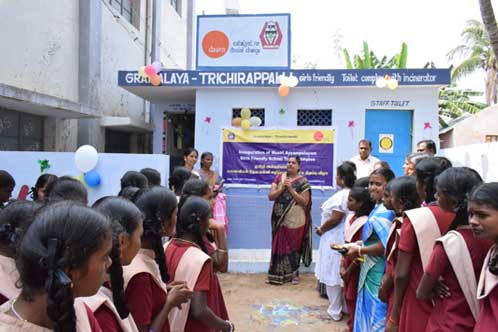The experience of building more than 100,000 toilets in 28 years has taught the Tiruchirappalli –based Gramalaya that smart is better than volume.
Here’s why our new toilet design is smart. Unlike septic tanks which require opening and emptying of the pits untreated in the open this toilet’s uses the content to make compost. They also come with attached bathroom and incinerator for safe disposal of sanitary napkins.
Smart toilets are scalable with community participation and funding from CSR. Collaborating with Swachh Bharat Mission program of the Government of India will give tremendous scale and reach.
The GOI-sponsored toilets cost Rs.12, 000/- twin leach pits size 4 ‘X 4′ size only toilet facility. The SMART toilets are 8’ x 4’ feet size with bathroom and incinerator. The SMART Toilet costs are between Rs.20, 000 and Rs.25, 000 depending upon the area, locally available materials.
Gramalaya has had support from Oracle, Wal-Mart, ONGC, Bank of America Merrill Lynch Capital, Ford, VST Industries- Hyderabad, and H T Parekh Foundation.
India plans to build 11 crore toilets. So far 5 crore household toilets are in use. However, success rate of these is not very encouraging. Success depends on how the communities are consulted, educated, and involved in the toilet construction process. Failure rates are high mostly because the contractors are purely driven by profit margin without a sense of hygiene management. Many are constructed without proper specifications as laid out by the Government of India.
Gramalaya has implemented innovative models including individual household toilets, micro-finance for sanitation, hygiene and health education, child friendly toilets in schools, school health education, community pay-and-use latrines, promotion of women Self-help Groups among rural, urban and tribal villages and school health programs primarily across five States in South India. It was instrumental in announcing India’s first village – Thandavampatti and India’s first slum – Kalmandhai open defecation free.
Gramalaya has established the National Institute of Water and Sanitation, a training resource center approved by Government of India. The center includes a Centre for Toilet Technology and Training to showcase more than 25 toilet models such as ecosan toilets and water less toilets. All models are tried and tested models which Gramalaya has successfully introduced in communities or schools.
Gramalaya has trained more than 100 NGOs and micro-finance Institutions in India for promoting water and sanitation in the country. It works with international organizations like WaterAid, Water.org, UNICEF, Arghyam and with State and Central Government in achieving the above target.
In 2015, the Ministry of Drinking Water and Sanitation, Government of India appointed Gramalaya as the National Key Resource Centers for providing WASH (Water, Sanitation and Hygiene) training and capacity building to senior government officials and NGOs in Andhra Pradesh, Karnataka, Telangana and Tamil Nadu. It also serves as Technical Support Unit for State-sponsored Sanitation scheme for rural and urban Department, Government of Tamil Nadu.
Gramalaya believes that improvement in people’s health help the communities to achieve faster social development.
Damodaran is the founder of Gramalaya.
Watch Gramalaya’s sanitary napkin initiative.
https://www.youtube.com/watch?v=PBowBWHh5CY







